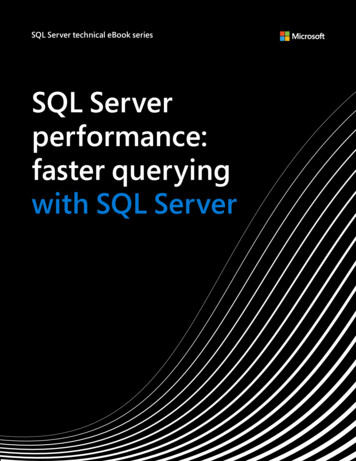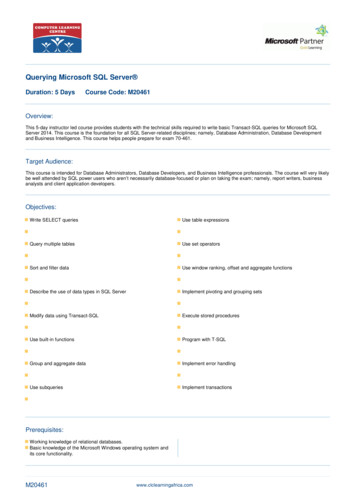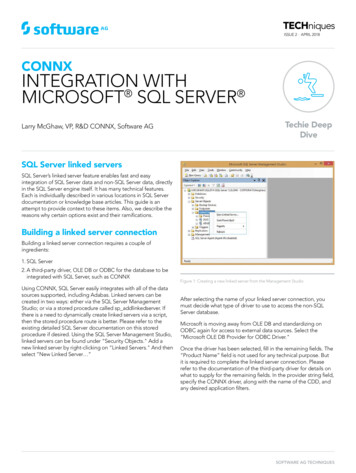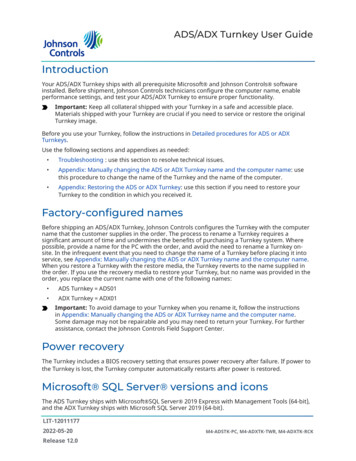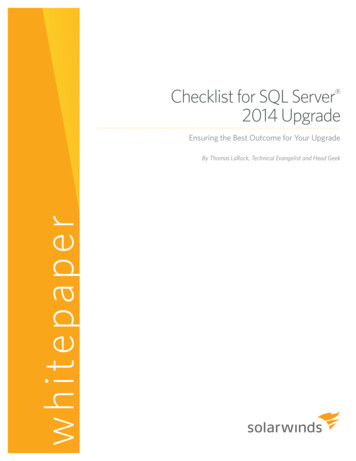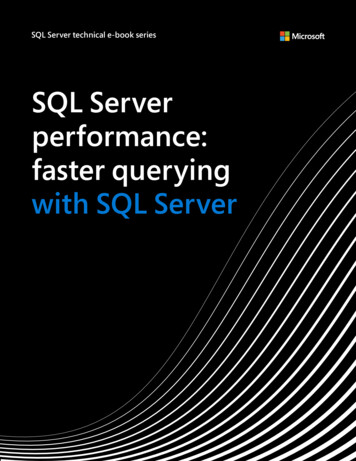
Transcription
SQL Server technical e-book series1SQL Serverperformance:faster queryingwith SQL Server
SQL Serverperformance:faster queryingwith SQL ServerContent01Introduction: Faster data growthdemands faster access02Faster querying with SQL Server03Database performance04Query performance05Additional performance-improvingtools and features06Setting the standard for speedand performance 2018 Microsoft Corporation. All rights reserved. Thisdocument is provided “as is.” Information and viewsexpressed in this document, including URL and otherinternet website references, may change without notice.You bear the risk of using it.This document does not provide you with any legal rightsto any intellectual property in any Microsoft product.You may copy and use this document for your internal,reference purposes.
3Who should readthis e-book?This e-book is for database architects, administrators, and developers lookingto accelerate query processing capabilities to support their most demandingdata-driven applications. By reading this e-book, you’ll learn how to get themost out of SQL Server, taking advantage of advanced built-in processingcapabilities including in-memory performance, security, analytics, andflexibility. This e-book covers tools and features like columnstore indexesand Adaptive Query Processing, with technical details on how to put thesecapabilities into practice.
Chapter 01Introduction: Faster data growth demands faster accessHow you handle data can bea difference-maker for yourbusiness.With data factoring in an increasing amount of interactions everywhere,it’s important to not only keep up with the volume of data but harness thepower of it.This need presents an opportunity for you to modernize your organization’sapplications and drive digital transformation with better built-in analytics. Byusing the most advanced business intelligence capabilities, you can make themost of the vast and varied data out there, accelerate your speed of doingbusiness through smarter decision-making and faster execution, and gain acompetitive advantageMicrosoft SQL Server can help you achieve this goal through the best andfastest platform available for your data and applications. SQL Server offerscritical built-in capabilities, including: Industry-leading1 in-memory performance Trusted security Game-changing in-database advanced analytics F lexibility to run your complete data estate on any environmentwith any dataGartner has rated Microsoft as a leader, with the most complete vision and highest ability to execute of any operational database management system,1 for three consecutive years. SQL Server Blog, Three years in a row—Microsoft is a leader in the ODBMS Magic Quadrant, November 3, 2017.01
Chapter 01Introduction: Faster data growth demands faster accessSQL Server combines higher speed with greater choice. By bringing the powerof SQL Server to Linux, Linux-based containers, and Windows, Microsoft enablesyou to decide which development languages, data types, environments (onpremises or cloud), and operating systems work best for your unique situation.IDC estimates that the amount of the global datasphere subject to dataanalysis will grow by a factor of50 to5.2 ZBin 2025.Source: IDC, Data Age 2025, April 201702
Chapter 02Faster querying with SQL Server03SQL Server deliversbuilt-in capabilities andfeatures that accelerateanalytics performanceand query processingto keep your databaseapplication at peak speed.SQL Server holds multiple top-performance benchmarks for transactionprocessing with leading business applications:Hewlett Packard Enterprise (HPE) announced a new world-record TPC-H10TB benchmark1 result using SQL Server 2017 and Windows Server 2016,demonstrating the leadership of SQL Server in price and performance. PE also announced the first TPC-H 3TB result2 and exhibited theHpower of SQL Server 2017 to handle analytic query workloads, includingdata warehouses. SQL Server is a proven leader for online transaction processing (OLTP)workloads. Lenovo recently announced a new world-record TPC-E benchmarkresult3 using SQL Server 2017 and Windows Server 2016. This is now the topTPC-E result in both performance and price/performance. QL Server holds a world-record 1TB TPC-H benchmark4 result (non-clustered)Sfor SQL Server on Red Hat Enterprise Linux. 110TB TPC-H non-clustered result as of November 9, 2017.23TB TPC-H non-clustered result as of November 9, 2017.3TPC-E benchmark result as of November 9, 2017.4TPC-H benchmark result on RHEL as of April 2017.
Chapter 03Database performance04Databases performboth simple andcomplex transactions.Depending on the types and level of complexity involved in performing thosetransactions, the amount of time it takes a database to return results canincrease significantly. When considering database optimization, it’s importantto know the types of transactions and the amount of throughput your databasewill need to sustain to be considered responsive enough.SQL Server has several features designed to increase transactional throughput.In-memory data processing can save significant time with certain types oftransactions. Columnstore indexes leverage column-based data storage toorganize large amounts of analytics-ready information in a compressed format.This makes lookups extremely fast compared to B-tree index searches done inrow-based data storage.In-memory dataBroadly speaking, in-memory data processing technology is faster because itsaves disk-seek and disk-read times. In-memory data processing also eliminateswait time due to lack of concurrency lockout, but without persistence it’svulnerable to the transient nature of RAM. That is, a sudden power failure canresult in data loss.SQL Server has added functionality to build upon the best of in-memory dataprocessing technology while mitigating the risks. This helps you to safely getmore out of In-Memory OLTP, dramatically improving throughput.
Chapter 03Database performance05Certain types of transactions are ideal candidates for In-Memory OLTP.Situations where transactions are short and plentiful will yield the mostperformance gain (especially if processing a high percentage of INSERTstatements), including sales transaction recording, high-volume Internet ofThings (IoT) or remote sensor reports, or ad clicks, just to name a few.Several features of SQL Server’s In-Memory OLTP can be combined to optimizeperformance depending on the type of data you’re processing:Memory-optimized tables. The key to In-Memory OLTP is the use of memoryoptimized tables—a special type of table data structure which is createdin memory and not on disk. Memory-optimized tables are said to take anoptimistic approach to concurrent transaction processing because they rely onthe fact that the chances of two UPDATE transactions affecting the same rowof data is very low. Therefore, a row isn’t locked before it’s updated. Instead,the system performs some quick validation at the time of commit and flags anyconflict that may occur, saving precious milliseconds of processing time.Non-durable tables. In SQL Server, memory-optimized tables are persistent bydefault although they can be configured to be non-persistent or non-durable ifthe risk of data loss is acceptable. They are used as temporary storage for queryresults or for caching.Memory-optimized table variables. This feature helps you with a variable thatis declared as an in-memory table. These variables store query results in sucha way that it’s easy to pass them to other statements or procedures, such asnatively compiled or interpreted stored procedures (the latter being used fordisk-based tables).Natively compiled stored procedures. A stored procedure has been compiledto native code and is able to access memory-optimized tables. Storedprocedures are compiled upon creation, which gives them an advantage overinterpreted stored procedures since error detection happens upon creationrather than at execution time. Higher performance gains are realized themore complex the logic and the more rows of data a natively compiled storedprocedure processes. Read more about best practices around the use ofnatively compiled stored procedures.
Chapter 03Database performance06Natively compiled scalar user-defined functions. Also called UDFs, theseuser-defined functions have been compiled to native code for faster executionon memory-optimized tables. UDFs defined in this way are only able to beexecuted on memory-optimized tables and not on traditional disk-based tables.SQL Server improves the performance of In-Memory OLTP workloads byremoving many of the limitations on tables and stored procedures foundin earlier product versions. Features introduced in 2017 make it easier tomigrate your applications and take advantage of the benefits of In-MemoryOLTP. Additionally, memory-optimized tables now support even faster OLTPworkloads with better throughput as a result of parallelized operations.SQL Serveralso offersthese benefits:The limitation of eight indexes for memory-optimized tables has beeneliminated. You can now create as many indexes on memory-optimized tablesas you can create on disk-based tables. Any disk-based table in your databasethat you could not migrate previously due to this limitation can now bememory-optimized. ransaction log redo of memory-optimized tables is now done in parallel.TThis bolsters faster recovery times and significantly increases the sustainedthroughput of Always On Availability Group configuration. erformance of Bw-Tree (non-clustered) index rebuild for MEMORYPOPTIMIZED tables during database recovery has been significantlyoptimized. This improvement substantially reduces database recovery timewhen non-clustered indexes are used. p spaceused is now supported for memory-optimized tables. It displayssthe number of rows, disk space reserved, and disk space used by a table,indexed view, or Service Broker queue in the current database. Alternatively, itdisplays the space reserved and used by the entire database.sp rename is now supported for memory-optimized tables and nativelycompiled T-SQL modules.
Chapter 03Database performance07Memory-optimized filegroup files can now be stored on Azure Storage.Backup/restore of memory-optimized files on Azure Storage is supported.Memory-optimized tables now support computed columns. Query surfacearea in native modules has been improved to include full support for JSONfunctions. Additional native support for query constructs, such as CROSSAPPLY, CASE, and TOP (N) WITH TIES, is now available.Dive deeper:In-Memory OLTPTo enable an application to use In-Memory OLTP, you can create a memoryoptimized table:CREATE TABLE SupportEvent()SupportEventIdint NOT NULLPRIMARY KEY NONCLUSTERED,.WITH (MEMORY OPTIMIZED ON,DURABILITY SCHEMA AND DATA);The MEMORY OPTIMIZED ON clause identifies a table as memory-optimizedand SCHEMA AND DATA, specifying that all changes to the table will be loggedand the table data is stored in memory. Every single memory-optimized tablemust contain at least one index. For more in-depth information about memory-optimized tables, seeMemory-Optimized Tables.
Chapter 03Database performanceYou can also create natively compiled stored procedures to access data inmemory-optimized tables. Here’s an example syntax:CREATE PROCEDURE dbo.usp add kitchen @dept id int, @kitchencount int NOT NULLWITH EXECUTE AS OWNER, SCHEMABINDING, NATIVE COMPILATIONASBEGIN ATOMIC WITH (TRANSACTION ISOLATION LEVEL SNAPSHOT, LANGUAGE N’usenglish’)UPDATE dbo.DepartmentsSET kitchen count ISNULL(kitchen count, 0) @kitchen countWHERE id @dept idEND;GOA procedure created without NATIVE COMPILATION cannot be altered to anatively compiled stored procedure. For a discussion of programmability in natively compiled storedprocedures, supported query surface area, and operators, seeSupported Features for Natively Compiled T-SQL Modules.08
Chapter 03Database performance09ColumnstoreindexesA columnstore index is a technology for storing and querying large amountsof data in a columnar format. This is one of the most powerful features ofSQL Server for high-speed analytic queries and large databases. Columnstoreindexes boost performance by compressing columnar data to reduce memoryand disk footprint, filtering scans automatically through rowgroup elimination,and processing queries in batches. With SQL Server columnstore indexes, youcan enable operational analytics—the ability to run real-time analytics on atransactional workload.SQL Server offers several capabilities for columnstore indexes, including: Non-clustered columnstore index (NCCI) online rebuild. Large objects (LOBs) support for columnstore indexes. Computed columns for clustered column index (CCI). Query optimizer features, like Machine Learning Services.Data stored as rowsDive deeper:ColumnstoreindexesData stored as columnsA columnstore index is either clustered or non-clustered. A clusteredcolumnstore index (CCI) is the physical storage for the entire table. Use a CCI tostore fact tables and large dimension tables for data warehousing workloads.A non-clustered columnstore index (NCCI) is a secondary index created ona rowstore table. Use an NCCI to perform analysis in real time on an OLTPworkload. A clustered columnstore index can have one or more non-clusteredB-tree indexes. To learn more about CCI and NCCI, go to Columnstore indexes – Overview.
Chapter 03Database performance10Dive deeper:Columnstoreindexes for datawarehousingCCIs are best suited for analytics queries, since analytics queries tend to performoperations on large ranges of values rather than looking up specific values.When you create a table with the CREATE TABLE statement, you can designatethe table as a CCI by creating a CLUSTERED COLUMNSTORE INDEX option:--Create the tableCREATE TABLE t account (AccountKey int NOT NULL,AccountDescription nvarchar (50),AccountType nvarchar(50),UnitSold int);GO--Store the table as a columnstore.CREATE CLUSTERED COLUMNSTORE INDEX taccount cci ON t account;GOYou can create non-clustered B-tree indexes as secondary indexes on a CCI. Tooptimize table seeks in a data warehouse, you can create an NCCI designed torun queries that perform best with these searches:CREATE NONCLUSTERED COLUMNSTORE INDEX taccount nc1 ON taccount (AccountKey);
Chapter 03Database performanceDive deeper:Columnstorefor a id transactional/analytical processing (HTAP) uses a columnstore indexon a rowstore table that you’re able to update. The columnstore indexkeeps a copy of the data, so the OLTP and analytics workloads run againstisolated copies of the data. This enables real-time analytical processing overtransactional data workloads without reduced performance. For each table,drop all B-tree indexes that are chiefly designed to accelerate existing analyticson your OLTP workload. Replace them with a solitary columnstore index. Seethe below example to create a non-clustered columnstore on the OLTP tablewith a filtered condition:CREATE TABLE t account (accountkey int PRIMARY KEY,accountdescription nvarchar (50),accounttype nvarchar(50),unitsold int);--Create the columnstore index with a filtered conditionCREATE NONCLUSTERED COLUMNSTORE INDEX account NCCION t account (accountkey, accountdescription, unitsold)11;The columnstore index on an in-memory table enables you to use operationalanalytics by integrating In-Memory OLTP and in-memory columnstoretechnologies, delivering high performance for both these workloads. Thecolumnstore index on an in-memory table must include all columns. Thisexample creates a memory-optimized table with a columnstore index:CREATE TABLE t account (accountkey int NOT NULL PRIMARY KEY NONCLUSTERED,Accountdescription nvarchar (50),accounttype nvarchar(50),unitsold int,INDEX t account cci CLUSTERED COLUMNSTORE)WITH (MEMORY OPTIMIZED ON );GO
Chapter 03Database performance12With this index creation, you can implement HTAP without making anychanges to your application. Analytics queries will run against the columnstoreindex and OLTP operations will keep running against your OLTP B-tree indexes.Non-clusteredcolumnstoreonline rebuildColumnstore indexes are an important component in keeping your queriesperformant. To maintain performance, these indexes need to be rebuiltperiodically which—for very large indexes—can take time. For any onlinebusiness, taking an application down for an hour means losing real moneyand possibly even worse. To keep your application up and running, SQL Serversupports online backups, consistency checks, and index rebuilds.In SQL Server, you can pause an index build and resume it at any time, evenafter a failure. You can rebuild indexes while they are still in use, and you canpause and resume those rebuilds, picking up exactly where the rebuild leftoff. You can enjoy the benefits of using less log space than the index rebuildoperations of previous releases.
Chapter 04Query performance13Poorly written queriescan degrade applicationperformance and hinderthe availability of criticalbusiness information.They can also lead to inefficient use of resources like CPU, memory, andnetwork. Regressions in query execution plans can also greatly impactperformance. These can occur if there have been application changes, staledatabase statistics, or inaccurate row count estimates. Even if your databaseserver runs on the most powerful hardware available, its performance can benegatively affected by a handful of misbehaving queries. In fact, even one badquery can cause serious performance issues for your database.Query performance depends on many factors, one of which is the query plan.When tuning and optimizing a poor query, a DBA usually starts by looking atthe execution plan of that query and evaluating it to determine the best andmost efficient plan based on data estimation. To help this process, SQL Serverprovides query processing and performance features that change the wayquery plans work:Query Store improvements enable you to track wait statistics summaryinformation, helping to reduce the time spent troubleshooting.Adaptive Query Processing (AQP) is a way of optimizing the SQL Serverexecution plan by mitigating errors in the query plan and adapting theexecution plan based on run results.
Chapter 04Query performanceQuery StoreQuery Store gathers telemetry on compilation-time and execution-timestatistics. It also captures query and plan history for your review. Data isseparated by time windows, so you can see database usage patterns andunderstand when query plan changes happened on the server.14Wait statistics are another source of information that help you troubleshootperformance issues in SQL Server. In the past, wait statistics were available onlyat the instance level, which made it difficult to backtrack details to the actualquery. Query Store helps you track wait statistics more efficiently by providingsummary information. Wait statistics are tied to a query plan and taken overtime, just like runtime statistics. This provides more insight into workloadperformance and bottlenecks, while preserving key Query Store advantages.Dive deeper:Using SQL ServerManagementStudio or TransactSQL Syntax forQuery StoreSQL Server Management Studio (SSMS) hosts a set of user interfaces designedfor configuring Query Store as well as for consuming collected data about yourworkloads. In Object Explorer in SSMS, you can enable Query Store by selectingthe Operation Mode (Requested) box:
Chapter 04Query performance15You can also use the ALTER DATABASE statement to implement theQuery Store. For example:ALTER DATABASE AdventureWorks2012 SET QUERY STORE ON;Once you’ve moved forward with either of these options, refresh the databaseportion of the Object Explorer pane to add the Query Store section. You’ll beable to see Query Store reports: For more information about how to monitor performance by using theQuery Store, see Microsoft documentation.
Chapter 04Query performanceAdaptive QueryProcessingDuring query processing and optimization, the cardinality estimation (CE)process is responsible for approximating the number of rows processed ateach step in an execution plan. Inaccurate estimations can result in slowquery response time, unnecessary resource utilization (memory, CPU, IO), andreduced throughput and concurrency.16To improve the CE process, SQL Server offers a feature family called AdaptiveQuery Processing (AQP). AQP makes SQL Server significantly faster atprocessing workloads by allowing the query processor to adjust query planchoices based on runtime characteristics. AQP breaks the barrier betweenquery plan and actual execution. Optimization can be done while the queryis executing or even after execution is complete, which benefits subsequentquery executions. AQP offers three techniques for adapting to applicationworkload characteristics: B atch mode memory grant feedback. B atch mode adaptive joins. I nterleaved execution for multistatement table-valued functions.Adaptive queryprocessingBatch modememory grantfeedbackBatch modeadaptive joinInterleavedexecution
Chapter 04Query performanceBatch modememory grantfeedbackFor a query’s post-execution plan, SQL Server takes a cardinality estimate fora given T-SQL batch and estimates the minimum memory grant needed forexecution as well as the ideal memory grant needed to hold all rows of thebatch in memory. If there are problems with the CE, performance suffers andavailable memory is constrained. Excessive memory grants result in wastedmemory and reduced concurrency. Insufficient memory grants cause expensivespills to disk.17With batch mode memory grant feedback, SQL Server recalculates the actualmemory required for a query and then updates the grant value for the cachedplan. When an identical query statement is executed, the query uses therevised memory grant size. Performance is improved because there are fewerspills to tempdb and, because memory grants to batches are more accurate,additional memory can be provided to the batches that need it most.For excessive grants, if the granted memory is more than two times the sizeof the used memory, memory grant feedback will recalculate and update thecached plan. Plans with memory grants under 1 MB will not be recalculated foroverages. For insufficiently sized memory grants that result in a spill to disk forbatch mode operators, memory grant feedback will trigger a recalculation. Spillevents are reported to memory grant feedback. This event returns the Node IDfrom the plan and the spilled data size of that node.Batch modeadaptive joinsSQL Server typically chooses among three types of physical join operators:nested loop joins, merge joins, and hash joins. Each type of join has strengthsand weaknesses, depending on the characteristics of the data and querypatterns. Which algorithm is best to use in each query depends on thecardinality estimates of the join inputs. Inaccurate input CEs can result in theselection of an inappropriate join algorithm.With the batch mode adaptive joins feature, SQL Server enables you to deferthe selection of a hash join or nested loop join method until after the firstinput has been scanned. The adaptive join operator defines a threshold that isused to decide when to switch to a nested loop plan. Consequenlty, a plan candynamically switch to a better join strategy during execution.
Chapter 04Query performance18Interleavedexecution nt table-valued functions (MSTVFs) are popular amongdevelopers although their initial execution can cause performance slowdowns.With the help of AQP, SQL Server resolves this issue through the interleavedexecution for MSTVFs feature. This feature changes the unidirectionalboundary between the optimization and execution phases for a single-queryexecution, and it enables plans to adapt based on the revised cardinalityestimates. With interleaved execution, the actual row counts from the MSTVFare used to make plan optimizations downstream from the MSTVF references.The result is a better-informed plan based on actual workload characteristicsand, ultimately, better query performance.When an MSTVF is encountered, the query optimizer will take thefollowing actions: P ause optimization. E xecute the MSTVF subtree to get an accurate CE. C ontinue processing subsequent operations with an accurate setof assumptions.Based on the execution results (estimated number of rows), the query optimizercan consider a better plan and execute the query with the modified plan.In general, the higher the skew between the estimated and actual number ofrows—coupled with the number of downstream plan operations—the greaterthe performance impact. Interleaved execution benefits queries where bothof the following are true: T here is a large skew between the estimated and actual number of rows forthe intermediate result set (in this case, the MSTVF). T he overall query is sensitive to a change in the size of the intermediateresult. This typically happens when there is a complex tree above the subtreein the query plan. A simple “SELECT *” from an MSTVF will not benefit frominterleaved execution.
Chapter 04Query performance19Dive deeper:Enabling AQPYou can make workloads automatically eligible for AQP by enablingcompatibility level 140 for the database. Here’s an example of how you can setthis using T-SQL:ALTER DATABASE [YourDatabaseName]SET COMPATIBILITY LEVEL 140; For more information about how to use these features, seeAdaptive query processing in SQL databases.
Chapter 05Additional performance-improving tools and features20There are also other toolsand features availableand supported by SQLServer for monitoringand optimizingperformance, includingfeature configurationoptions and monitoringand tuning features.Featureconfigurationoptions forperformanceSQL Server offers various configuration options for disk, server, table, andquery at the database engine level for further improving the SQL Serverperformance.Disk configuration. You can set redundant array of independent disks (RAID)levels 0, 1, and 5 with SQL Server. Configure RAID level 0 for disk stripping, 1 fordisk mirroring, and 5 striping with parity to be used with SQL Server.Tempdb configuration. For optimizing tempdb performance, you can useoptions such as database instant file initialization, autogrow, and disk stripingto keep tempdb in your local drive instead of the shared network drive. Forfurther details, see Optimizing tempdb performance in SQL Server.
Chapter 05Additional performance-improving tools and features21Server configuration. You can configure settings for processor, memory, index,backup, and query to enhance the server performance with SQL Server. Thesesettings include options for a maximum degree of parallelism like MAXDOP,max server memory, optimize for ad hoc workloads, and nested triggers. Forfurther details, see Configuration Options for Performance.Database configuration. Set row and page compression using the datacompression function for rowstore and columnstore tables and indexes tooptimize the database performance. You can also change the compatibilitylevel of a database based on your requirements.Table configuration. You can use partitioned tables and indexes for improvingtable performance.Query performance options. For enhancing query level performance, you canuse indexes, partitions, stored procedures, UDFs, and statistics. Use previouslydiscussed features like memory-optimized tables and natively compiledstored procedures to improve In-Memory OLTP performance. See the QueryPerformance Options for further details.Monitoring andtuning features forperformanceTools like Query Store, execution plans, live query statistics, and DatabaseEngine Tuning Advisor can help you monitor SQL Server events. You can alsouse various T-SQL commands like sp trace setfilter to tracks engine processevents or DBCC TRACEON, a command to enable trace flags. Additionally, youcan also establish a performance baseline using sp configure to determinewhether your SQL Server system is performing optimally or not. For moreinformation, see Performance Monitoring and Tuning Tools.Resource GovernorResource Governor is a tool in SQL Server that helps you manage and specifylimits on the system resource consumptions. You can simply define the resourcelimit on CPU, physical I/O, and memory that incoming application requestscan use. Using Resource Governor, you can continually observe resource usagepatterns and adjust the system settings accordingly for maximize effectiveness.To dive deeper into its usage and how it works, see Resource Governordocumentation.
Chapter 06Setting the standard for speed and performance22SQL Server 2017 delivers fasterprocessing capabilities to supportyour most demanding data-drivenapplications. It includes a uniqueset of features built on industryleading, advanced performancecapabilities.In-Memory OLTP provides faster online transaction processing workloadsand better throughput. Columnstore indexes improve database performanceand boost high-speed analytics. Plus, features like Adaptive Query Processingenable DBAs to further optimize their query processing capabilities. SQL Server2017 provides the speed, features, and scalability that organizations need tokeep their work up and running at the pace their users demand. See how to runSQL Server on yourfavorite platform.Learn about thelatest features inSQL Server.View SQL industrybenchmarks andperformance.DownloadSQL Server.
result3 using SQL Server 2017 and Windows Server 2016. This is now the top TPC-E result in both performance and price/performance. SQL Server holds a world-record 1TB TPC-H benchmark 4 result (non-clustered) for SQL Server on Red Hat Enterprise Linux. Chapter 02 Faster querying with SQL Server 1 10TB TPC-H non-clustered result as of November 9 .
